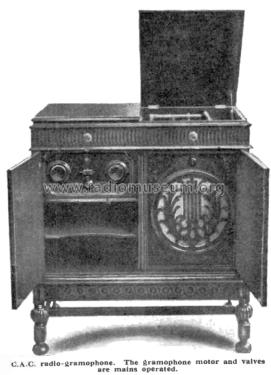C.A.C. Radiogramophone
CAC (C.A.C.) City Accumulator Co. (Radio Ltd. Valve/Cabinets); London
- País
- Gran Bretaña (GB)
- Fabricante / Marca
- CAC (C.A.C.) City Accumulator Co. (Radio Ltd. Valve/Cabinets); London
- Año
- 1929
- Categoría
- Radio - o Sintonizador pasado WW2
- Radiomuseum.org ID
- 346867
-
- Brand: CAC
- Numero de valvulas
- 5
- Válvulas
- Principio principal
- RFS con reacción (regenerativo)
- Gama de ondas
- OM (onda media) solamente
- Especialidades
- Tocadiscos (sin cambiador autom)
- Tensión de funcionamiento
- Red / Baterías o pilas
- Altavoz
- -Altavoz incorporado, sistema desconocido.
- Material
- Madera
- de Radiomuseum.org
- Modelo: C.A.C. Radiogramophone - CAC C.A.C. City Accumulator Co
- Forma
- Consola baja, patas más cortas del 50%.
- Anotaciones
-
The £75 model illustrated incorporates a B.T.H. pick-up and a G.E.C. universal (D.C. or A.C.) motor and an automatic device that cuts out the motor and breaks the valve current when the record has been played.
A pilot light gives a warning when the motor is running and also serves, as a series resistance to reduce the mains voltage. A ½ megohm variable resistance (volume control) shunts the pickup output, which is fed to four Cosmos A.C. valves.
Batteries (except grid bias) are replaced by a Cosmos eliminator, and a choke-filter unit feeds the final output to an " Ultra " balanced armature with folded exponential horn loudspeaker.
For radio, five valves are employed, the first, a H.F. valve, is the new indirectly heated screen-grid valve (AC/S) which is carefully screened in a copper box. The three L.F. valves are coupled by the " C.A.C. coupler," which consists of 47-gauge Eureka wire-wound transformers without any iron core.
The coupling between primary and secondary is tight so there is probably considerable capacity between these windings.
No attempt to explain this unorthodox amplifier can be made here, but suffice it to say that very considerable volume is available and that the high notes do not appear to be missing, as might be the case if a conventional multi-stage resistance amplifier were employed.
An indoor or outdoor aerial is required for radio, whilst for tuning there are two controls, together with a capacity control of reaction
- Precio durante el primer año
- 75.00 GB £
- Mencionado en
- Wireless World (The), London (WW, 79) (Mar 6, 1929, Page 241.)
- Autor
- Modelo creado por Gary Cowans. Ver en "Modificar Ficha" los participantes posteriores.
- Otros modelos
-
Donde encontrará 10 modelos, 9 con imágenes y 1 con esquemas.
Ir al listado general de CAC (C.A.C.) City Accumulator Co. (Radio Ltd. Valve/Cabinets); London
